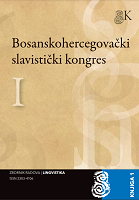Bosanskohercegovački lingvistički atlas: Dvije ankete i jedna izoglosa
A Bosnian and Herzegovinian Linguistic Atlas: two surveys, one isogloss
Author(s): Senahid HalilovićSubject(s): Historical Linguistics, Sociolinguistics, South Slavic Languages
Published by: Slavistički komitet BiH
Keywords: Survey; dialect; dialectology; isogloss; questionnaire; Linguistic Atlas; Slavic Studies Congress;
Summary/Abstract: The first part of this paper deals with two surveys conducted at different points in the previous two centuries to research the spoken languages of Bosnia and Herzegovinia. Due to unfavorable social circumstances, neither survey was worked up to provide a Bosnian and Herzegovinian Linguistic Atlas. At the end of the 19th century the National Government in BiH was planning a Slavic Studies Congress in Sarajevo. The Government therefore hired two prominent Slavicists, V. Jagić and M. Rešetar, to prepare a survey questionnaire to provide some insight into the basic characteristics of the various forms of spoken language of Bosnia and Herzegovinia. Rešetar’s questionnaire contained 150 questions to which answers were collected from 215 locations. The survey was conducted in 1897, and so at a time when the first linguistic atlases were being prepared in Europe. It was organized by the National Museum in Sarajevo, where the material is still kept today. The data from the survey allows a quite reliable dialectal picture to be reconstructed for the heartland of the Central-South-Slavic language at the end of the 19th century. The second survey was conducted by the Language Institute from 1975 to 1986 as part of a Project on “The Bosnian and Herzegovinian Dialectal Complex – A Synchronic Description and Comparison with the Standard Language”. A questionnaire with 2,058 questions was filled in with reference to 224 local dialectal variants. One part of the material from the questionnaire was processed and published in the Bosnian and Herzegovinian Journal of Dialectology. The second part of the paper provides a systematic overview of the data provided by the questionnaires from these two surveys with regard to the reflexes of jat and of the Proto-Slavic cluster *st’ in the word kliješta. The map presents the Ijekavian and Ikavian as well as the Štakavian-Šćakavian areas, at the same time as it provides an answer to the question of whether the Ijekavian-Ikavian and the Štakavian-Šćakavian borders changed between the end of the 19th and the end of the 20th century. Using just one isogloss as an example, we hope to demonstrate the importance of this material for dialectology and the history of the Bosnian, Croatian and Serbian languages, as well as the need for a Bosnian and Herzegovinian Linguistic Atlas.
Journal: Bosanskohercegovački slavistički kongres
- Issue Year: I/2012
- Issue No: 1
- Page Range: 171-183
- Page Count: 13
- Language: Bosnian

